| Article ID | Journal | Published Year | Pages | File Type |
|---|---|---|---|---|
| 10609293 | European Polymer Journal | 2005 | 11 Pages |
Abstract
The oxidative condensation of (5-amino-2,3-dihydro-1,4-phtalazinedione) luminol was carried out under their oxidation by (NH4)2S2O8 and KIO3 in the mixed water-organic (namely dimethyl sulfoxide (DMSO), N,N-dimethylformamide (DMF) or N-methyl-2-pyrrolidinone (MPD)) solvent under the volume ratio 1:9. The structure of the products was studied by IR and Raman spectroscopy, elemental analysis and the derivatographic method. It was determined that oxidation by KIO3 (E = 1.085 V) occurs on the amide nitrogen atoms, while in the case of (NH4)2S2O8 (E = 2.05 V) it occurs on the amino-group. The structure and thermal stability of the obtained products is determined by the nature of the oxidant. The active decomposition of luminol begins at td = 334.5 °C, while for the specimens of the polyluminols, which were synthesized in the water-DMSO and water-MPD mixtures, td equals 356.7 and 409.1 °C respectively. The worst thermal stability has products of luminol oxidation by KIO3 (td = 282.5 °C). The mechanism of the luminol oxidative polymerization by (NH4)2S2O8 and KIO3 has been proposed.
Related Topics
Physical Sciences and Engineering
Chemistry
Organic Chemistry
Authors
Eugen P. Koval'chuk, Iryna V. Grynchyshyn, Oleksandr V. Reshetnyak, Roman Ye. Gladyshevs'kyj, Jerzy BÅażejowski,
